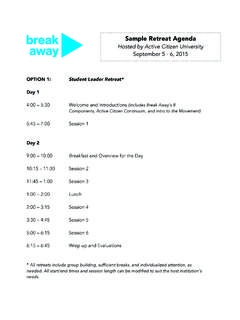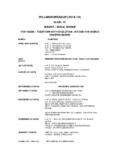Transcription of What the World’s Greatest Managers Do Differently
1 From Soundview Executive Book Summaries February 2000 first , BREAK ALL THERULESWhat the World s Greatest Managers Do DifferentlyBy Marcus Buckingham and Curt CoffmanTHE SUMMARY IN BRIEFB ased on in-depth interviews with more than80,000 Managers at all levels (and in companies of allsizes), the Gallup Organization s Buckingham andCoffman reveal in this summary what greatmanagers do Differently from ordinary Managers tocoax world class performance out of their Managers , write the authors, routinelybreak all the rules . They take the conventionalwisdom about human nature and managing peopleand turn it upside this summary you will learn whichconventional wisdoms to ignore. first , you will finda simple list of twelve questions that will help youassess whether your workplace is the kind of placethat will attract and keep the best will then learn the four keys for unlockingthe potential of each and every one of first key is to select employees based ontalent rather than experience or intelligence.
2 Thissummary will help you learn what talent is and whyyou can t create it from second key is to evaluate performance basedon desired outcomes rather than direct control overthe way a worker performs his or her job. You willlearn how to define outcomes so performance canbe measured and third key to great management is to reject theconventional wisdom that people can be on strength, the authors urge, not onweaknesses. You will learn how to manage fourth and final key is to find the right fit foryour employees talents. Again, you will learn toavoid the conventional wisdom that promotion isthe only just reward for high performance - mindsetthat creates an organization where everyone isultimately promoted to their level of Buckingham is the leader of The Gallup Organization s twenty-year effort to identifythe core characteristics of great Managers and great workplaces.
3 He is also a senior lecturer inGallup s Leadership Institute. Curt Coffman is the global practice leader for the GallupOrganization s Workplace Management Practice. He consults regularly on the development ofproductive customer-oriented summary of first , break all the rules , What the World s Greatest ManagersDo Differently (Simon & Schuster, 1999) is from Soundview Executive Book Summaries,10 LaCrue Avenue, Concordville, PA , break all the rules from Soundview Executive Book Summaries February 20002 THE THE COMPLETE SUMMARYThe Measuring Stick Today, more than ever, employers realize they mustfind and keep top talent for every role. And theapproach many of them are taking is to offer an arrayof carrots to keep employees happy and around. Theproblem is that carrots in the form of perks areexpensive and may not accomplish their don t distinguish between great performers,mediocre performers or poor ones.
4 Your job, ofcourse, is to attract and keep top , the measures you and your company areusing to determine if you are succeeding may not accu-rately reflect what is really need a new measuring stick. That stick is anassessment of the strength of your workplace. Throughan extensive survey, the Gallup Organization has isolat-ed the 12 characteristics of a strong workplace as thatworkplace is seen through the eyes of the most success-ful and productive employees. If employees can answereach of the following 12 questions affirmatively, youhave a strong workplace, a workplace where the bestwant to work and stay. I know what is expected of me at work? I have the equipment and material I need to domy work right? work, do I have the opportunity to do what I dobest every day? the last seven days, have I received recogni-tion or praise for good work? my supervisor or someone at work seem tocare about me as a person?
5 There someone at work who encourages mydevelopment? work, do my opinions seem to count? the mission/purpose of my company makeme feel my work is important? my co-workers committed to doing qualitywork? 10. Do I have a best friend at work? 11. In the last six months, have I talked to someone about my progress? 12. This last year, have I had opportunities at work to learn and grow? As a manager , it is your job to make sure employeescan respond with a resounding yes to these dozenquestions. If they can, you likely have a strongworkplace capable of attracting and keeping topperformers at every level from the bottom to the top. You probably noticed that there are no questionsabout pay, benefits, senior management ororganizational structure on the list. The reason is thatthose are important to every employee, good, bad ormediocre.
6 Therefore, they aren t a true measure of ahealthy and strong workplace. A workplace withnothing but low-performing employees but an excellentbenefit plan would fare very well on a survey, but thesurvey responses would say nothing about how well thecompany attracts and keeps the best. And therein liesthe folly of the best places to work type surveys. Justbecause a place is a good place to work doesn t mean itwill attract good workers. It may be a popular but weakworkplace. To test this theory, The Gallup Organizationsurveyed 2,500 business units. After assessing theirproductivity, profitability, retention levels and customerratings, employees were asked to answer the 12questions. Consistently, the companies that ranked highest inthe four measures of success had workers whoanswered the questions affirmatively and is, the best business units had more workersrespond that they strongly agreed with each of the 12questions while the worst business units had fewerworkers respond that way.
7 There was a clear linkbetween employee opinion and business are the key to a strong who create an environment where workerscan answer the questions positively are the managerswho will attract and retain the best. What a Strong Workplace Looks Like Lankford-Sysco is a strong workplace. The Ocean City, MD,workplace doesn t look very special. The warehouses are coldand foreboding. Workers clad in arctic wear move crates in andout of deep freezers. But as you continue your tour, you quicklynotice the workers are focused and cheerful. In the lobby thereis a huge mural depicting company history as well as anemployee portrait gallery. The company is part of a $15 billionfood distribution giant, yet resembles the small, family ownedoperation it was before merging with industry giant Sysco. The company has a turnover rate in the single digits,absenteeism is at an all-time low, and theft is virtually non-existent.
8 Company executives think they know the employee is paid for performance regardless of whatposition he or she holds. Managers constantly talk about theimportance of customers and say they treat workers withrespect and really listen to their concerns. In turn, workersmeasure their success by personal bests like breakage recordsand miles traveled without accidents. Virtually everyone wouldanswer yes to the 12 measuring stick , break all the rules from Soundview Executive Book Summaries February 20003 The Wisdom of Great Managers How do the best Managers in the world lay the foun-dations of a strong workplace? The GallupOrganization set out to answer that question in phasetwo of a massive survey project. first , the researcherasked clients to identify their best Managers , the ones you would dearly love to clone.
9 Next, the managerswere evaluated by standard measures such as theproductivity and profitability of their divisions,employee accidents, shrinkage, customer feedback andemployee opinion. Those who scored the best overallwere interviewed and asked about their , another group of Managers was identified. Thisgroup did not perform anywhere near the level of thefirst set. Instead, they could best be characterized asmediocre. They, too,completed the the results werecompared, a remarkablediscovery came to Managers break all therules. They ignore the con-ventional wisdom that saysmanagement s job is toidentify worker weaknessesand devise a plan to correctand overcome thoseweaknesses. Instead, theyoperate on the assumptionthat people don t andprobably can t change manyof the traits they Managers recognizethe futility in demandingchange and concentrateinstead on developingemployee are not LeadersIf your company is goingto succeed in developing great Managers , it had bestbegin by breaking the conventional rule that managersare just leaders in waiting.
10 Great Managers need to berecognized for what they do best; reaching inside aworker and encouraging exceptional performance. Thatis not the same as being a great Managers look inward, inside the company,into the individual, into the differences in style, goals,needs and motivations of each person. They then findthe right way to release each person s unique talentsinto great performance. By contrast, great leaders lookoutward. They look out of the company, into thefuture, and seek out alternative routes. They arevisionaries, strategic thinkers, activators. The coreactivities of a manager and a leader are very different. Ifyou want great Managers , you must stop insisting thatthey be great leaders and let them concentrate on theirtalent: wary of compensation systems that identifycountless competencies for Managers and expectevery manager to possess them all.




